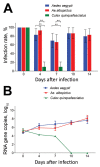Competence of Aedes aegypti, Ae. albopictus, and Culex quinquefasciatus Mosquitoes as Zika Virus Vectors, China
- PMID: 28430562
- PMCID: PMC5512498
- DOI: 10.3201/eid2307.161528
Competence of Aedes aegypti, Ae. albopictus, and Culex quinquefasciatus Mosquitoes as Zika Virus Vectors, China
Abstract
In China, the prevention and control of Zika virus disease has been a public health threat since the first imported case was reported in February 2016. To determine the vector competence of potential vector mosquito species, we experimentally infected Aedes aegypti, Ae. albopictus, and Culex quinquefasciatus mosquitoes and determined infection rates, dissemination rates, and transmission rates. We found the highest vector competence for the imported Zika virus in Ae. aegypti mosquitoes, some susceptibility of Ae. albopictus mosquitoes, but no transmission ability for Cx. quinquefasciatus mosquitoes. Considering that, in China, Ae. albopictus mosquitoes are widely distributed but Ae. aegypti mosquito distribution is limited, Ae. albopictus mosquitoes are a potential primary vector for Zika virus and should be targeted in vector control strategies.
Keywords: Aedes aegypti; Aedes albopictus; China; Culex quinquefasciatus; Zika virus; mosquitoes; vector competence; vector-borne infections; viruses.
Figures



Similar articles
-
Effects of Zika Virus Strain and Aedes Mosquito Species on Vector Competence.Emerg Infect Dis. 2017 Jul;23(7):1110-1117. doi: 10.3201/eid2307.161633. Epub 2017 Jul 15. Emerg Infect Dis. 2017. PMID: 28430564 Free PMC article.
-
Contrasted transmission efficiency of Zika virus strains by mosquito species Aedes aegypti, Aedes albopictus and Culex quinquefasciatus from Reunion Island.Parasit Vectors. 2020 Aug 6;13(1):398. doi: 10.1186/s13071-020-04267-z. Parasit Vectors. 2020. PMID: 32762767 Free PMC article.
-
Vector competence of Virginia mosquitoes for Zika and Cache Valley viruses.Parasit Vectors. 2020 Apr 10;13(1):188. doi: 10.1186/s13071-020-04042-0. Parasit Vectors. 2020. PMID: 32276649 Free PMC article.
-
Zika virus: An updated review of competent or naturally infected mosquitoes.PLoS Negl Trop Dis. 2017 Nov 16;11(11):e0005933. doi: 10.1371/journal.pntd.0005933. eCollection 2017 Nov. PLoS Negl Trop Dis. 2017. PMID: 29145400 Free PMC article.
-
Aedes albopictus is a competent vector of Zika virus: A meta-analysis.PLoS One. 2019 May 21;14(5):e0216794. doi: 10.1371/journal.pone.0216794. eCollection 2019. PLoS One. 2019. PMID: 31112569 Free PMC article.
Cited by
-
Combining Wolbachia-induced sterility and virus protection to fight Aedes albopictus-borne viruses.PLoS Negl Trop Dis. 2018 Jul 18;12(7):e0006626. doi: 10.1371/journal.pntd.0006626. eCollection 2018 Jul. PLoS Negl Trop Dis. 2018. PMID: 30020933 Free PMC article.
-
Lack of evidence for Zika virus transmission by Culex mosquitoes.Emerg Microbes Infect. 2017 Oct 18;6(10):e90. doi: 10.1038/emi.2017.85. Emerg Microbes Infect. 2017. PMID: 29044195 Free PMC article. No abstract available.
-
Modes of Transmission of Zika Virus.J Infect Dis. 2017 Dec 16;216(suppl_10):S875-S883. doi: 10.1093/infdis/jix396. J Infect Dis. 2017. PMID: 29267909 Free PMC article. Review.
-
Detailed Analyses of Zika Virus Tropism in Culex quinquefasciatus Reveal Systemic Refractoriness.mBio. 2020 Aug 18;11(4):e01765-20. doi: 10.1128/mBio.01765-20. mBio. 2020. PMID: 32817107 Free PMC article.
-
Health preparedness plan for dengue detection during the 2020 summer Olympic and Paralympic games in Tokyo.PLoS Negl Trop Dis. 2018 Sep 20;12(9):e0006755. doi: 10.1371/journal.pntd.0006755. eCollection 2018 Sep. PLoS Negl Trop Dis. 2018. PMID: 30235211 Free PMC article.
References
MeSH terms
Substances
Grants and funding
LinkOut - more resources
Full Text Sources
Other Literature Sources
Medical

